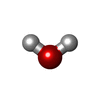[English] 日本語
 Yorodumi
Yorodumi- EMDB-45170: Structure of the CNOT3-bound human 80S ribosome with tRNA-ARG in ... -
+ Open data
Open data
- Basic information
Basic information
| Entry |  | ||||||||||||||||||||||||
|---|---|---|---|---|---|---|---|---|---|---|---|---|---|---|---|---|---|---|---|---|---|---|---|---|---|
| Title | Structure of the CNOT3-bound human 80S ribosome with tRNA-ARG in the P-site. | ||||||||||||||||||||||||
 Map data Map data | |||||||||||||||||||||||||
 Sample Sample |
| ||||||||||||||||||||||||
 Keywords Keywords | mRNA degradation / CCR4-NOT complex / tRNA / RIBOSOME | ||||||||||||||||||||||||
| Function / homology |  Function and homology information Function and homology informationCCR4-NOT core complex / CCR4-NOT complex / regulation of stem cell population maintenance / nuclear-transcribed mRNA poly(A) tail shortening / trophectodermal cell differentiation / Deadenylation of mRNA / translation at presynapse / embryonic brain development / exit from mitosis / eukaryotic 80S initiation complex ...CCR4-NOT core complex / CCR4-NOT complex / regulation of stem cell population maintenance / nuclear-transcribed mRNA poly(A) tail shortening / trophectodermal cell differentiation / Deadenylation of mRNA / translation at presynapse / embryonic brain development / exit from mitosis / eukaryotic 80S initiation complex / negative regulation of protein neddylation / response to insecticide / optic nerve development / regulation of translation involved in cellular response to UV / M-decay: degradation of maternal mRNAs by maternally stored factors / negative regulation of endoplasmic reticulum unfolded protein response / oxidized pyrimidine DNA binding / response to TNF agonist / positive regulation of base-excision repair / axial mesoderm development / negative regulation of formation of translation preinitiation complex / positive regulation of respiratory burst involved in inflammatory response / regulation of G1 to G0 transition / ribosomal protein import into nucleus / positive regulation of intrinsic apoptotic signaling pathway in response to DNA damage / positive regulation of gastrulation / protein tyrosine kinase inhibitor activity / protein-DNA complex disassembly / positive regulation of endodeoxyribonuclease activity / IRE1-RACK1-PP2A complex / nucleolus organization / positive regulation of Golgi to plasma membrane protein transport / positive regulation of intrinsic apoptotic signaling pathway in response to DNA damage by p53 class mediator / regulatory ncRNA-mediated gene silencing / 90S preribosome assembly / retinal ganglion cell axon guidance / TNFR1-mediated ceramide production / negative regulation of DNA repair / negative regulation of RNA splicing / GAIT complex / positive regulation of DNA damage response, signal transduction by p53 class mediator / supercoiled DNA binding / TORC2 complex binding / neural crest cell differentiation / alpha-beta T cell differentiation / G1 to G0 transition / NF-kappaB complex / TP53 regulates transcription of additional cell cycle genes whose exact role in the p53 pathway remain uncertain / cysteine-type endopeptidase activator activity involved in apoptotic process / oxidized purine DNA binding / positive regulation of ubiquitin-protein transferase activity / negative regulation of intrinsic apoptotic signaling pathway in response to hydrogen peroxide / regulation of establishment of cell polarity / negative regulation of bicellular tight junction assembly / ubiquitin-like protein conjugating enzyme binding / middle ear morphogenesis / negative regulation of phagocytosis / rRNA modification in the nucleus and cytosol / Formation of the ternary complex, and subsequently, the 43S complex / erythrocyte homeostasis / cytoplasmic side of rough endoplasmic reticulum membrane / laminin receptor activity / negative regulation of ubiquitin protein ligase activity / protein kinase A binding / ion channel inhibitor activity / Ribosomal scanning and start codon recognition / pigmentation / homeostatic process / Translation initiation complex formation / positive regulation of mitochondrial depolarization / macrophage chemotaxis / positive regulation of T cell receptor signaling pathway / negative regulation of Wnt signaling pathway / fibroblast growth factor binding / lung morphogenesis / monocyte chemotaxis / positive regulation of natural killer cell proliferation / positive regulation of activated T cell proliferation / negative regulation of translational frameshifting / TOR signaling / Protein hydroxylation / BH3 domain binding / SARS-CoV-1 modulates host translation machinery / regulation of adenylate cyclase-activating G protein-coupled receptor signaling pathway / iron-sulfur cluster binding / regulation of cell division / cellular response to ethanol / mTORC1-mediated signalling / Peptide chain elongation / Selenocysteine synthesis / Formation of a pool of free 40S subunits / positive regulation of intrinsic apoptotic signaling pathway by p53 class mediator / endonucleolytic cleavage to generate mature 3'-end of SSU-rRNA from (SSU-rRNA, 5.8S rRNA, LSU-rRNA) / Eukaryotic Translation Termination / ubiquitin ligase inhibitor activity / positive regulation of GTPase activity / cellular response to actinomycin D / Response of EIF2AK4 (GCN2) to amino acid deficiency / blastocyst development / SRP-dependent cotranslational protein targeting to membrane Similarity search - Function | ||||||||||||||||||||||||
| Biological species |  Homo sapiens (human) Homo sapiens (human) | ||||||||||||||||||||||||
| Method | single particle reconstruction / cryo EM / Resolution: 2.0 Å | ||||||||||||||||||||||||
 Authors Authors | Erzberger JP / Cruz VE | ||||||||||||||||||||||||
| Funding support |  United States, 7 items United States, 7 items
| ||||||||||||||||||||||||
 Citation Citation |  Journal: Science / Year: 2024 Journal: Science / Year: 2024Title: Specific tRNAs promote mRNA decay by recruiting the CCR4-NOT complex to translating ribosomes. Authors: Xiaoqiang Zhu / Victor Emmanuel Cruz / He Zhang / Jan P Erzberger / Joshua T Mendell /  Abstract: The CCR4-NOT complex is a major regulator of eukaryotic messenger RNA (mRNA) stability. Slow decoding during translation promotes association of CCR4-NOT with ribosomes, accelerating mRNA degradation. ...The CCR4-NOT complex is a major regulator of eukaryotic messenger RNA (mRNA) stability. Slow decoding during translation promotes association of CCR4-NOT with ribosomes, accelerating mRNA degradation. We applied selective ribosome profiling to further investigate the determinants of CCR4-NOT recruitment to ribosomes in mammalian cells. This revealed that specific arginine codons in the P-site are strong signals for ribosomal recruitment of human CNOT3, a CCR4-NOT subunit. Cryo-electron microscopy and transfer RNA (tRNA) mutagenesis demonstrated that the D-arms of select arginine tRNAs interact with CNOT3 and promote its recruitment whereas other tRNA D-arms sterically clash with CNOT3. These effects link codon content to mRNA stability. Thus, in addition to their canonical decoding function, tRNAs directly engage regulatory complexes during translation, a mechanism we term P-site tRNA-mediated mRNA decay. | ||||||||||||||||||||||||
| History |
|
- Structure visualization
Structure visualization
| Supplemental images |
|---|
- Downloads & links
Downloads & links
-EMDB archive
| Map data |  emd_45170.map.gz emd_45170.map.gz | 322 MB |  EMDB map data format EMDB map data format | |
|---|---|---|---|---|
| Header (meta data) |  emd-45170-v30.xml emd-45170-v30.xml emd-45170.xml emd-45170.xml | 105.9 KB 105.9 KB | Display Display |  EMDB header EMDB header |
| FSC (resolution estimation) |  emd_45170_fsc.xml emd_45170_fsc.xml | 15.7 KB | Display |  FSC data file FSC data file |
| Images |  emd_45170.png emd_45170.png | 152.6 KB | ||
| Filedesc metadata |  emd-45170.cif.gz emd-45170.cif.gz | 21.5 KB | ||
| Others |  emd_45170_half_map_1.map.gz emd_45170_half_map_1.map.gz emd_45170_half_map_2.map.gz emd_45170_half_map_2.map.gz | 274.1 MB 274.7 MB | ||
| Archive directory |  http://ftp.pdbj.org/pub/emdb/structures/EMD-45170 http://ftp.pdbj.org/pub/emdb/structures/EMD-45170 ftp://ftp.pdbj.org/pub/emdb/structures/EMD-45170 ftp://ftp.pdbj.org/pub/emdb/structures/EMD-45170 | HTTPS FTP |
-Validation report
| Summary document |  emd_45170_validation.pdf.gz emd_45170_validation.pdf.gz | 1.1 MB | Display |  EMDB validaton report EMDB validaton report |
|---|---|---|---|---|
| Full document |  emd_45170_full_validation.pdf.gz emd_45170_full_validation.pdf.gz | 1.1 MB | Display | |
| Data in XML |  emd_45170_validation.xml.gz emd_45170_validation.xml.gz | 23.4 KB | Display | |
| Data in CIF |  emd_45170_validation.cif.gz emd_45170_validation.cif.gz | 31.3 KB | Display | |
| Arichive directory |  https://ftp.pdbj.org/pub/emdb/validation_reports/EMD-45170 https://ftp.pdbj.org/pub/emdb/validation_reports/EMD-45170 ftp://ftp.pdbj.org/pub/emdb/validation_reports/EMD-45170 ftp://ftp.pdbj.org/pub/emdb/validation_reports/EMD-45170 | HTTPS FTP |
-Related structure data
| Related structure data |  9c3hMC  9c3iC M: atomic model generated by this map C: citing same article ( |
|---|---|
| Similar structure data | Similarity search - Function & homology  F&H Search F&H Search |
- Links
Links
| EMDB pages |  EMDB (EBI/PDBe) / EMDB (EBI/PDBe) /  EMDataResource EMDataResource |
|---|---|
| Related items in Molecule of the Month |
- Map
Map
| File |  Download / File: emd_45170.map.gz / Format: CCP4 / Size: 343 MB / Type: IMAGE STORED AS FLOATING POINT NUMBER (4 BYTES) Download / File: emd_45170.map.gz / Format: CCP4 / Size: 343 MB / Type: IMAGE STORED AS FLOATING POINT NUMBER (4 BYTES) | ||||||||||||||||||||||||||||||||||||
|---|---|---|---|---|---|---|---|---|---|---|---|---|---|---|---|---|---|---|---|---|---|---|---|---|---|---|---|---|---|---|---|---|---|---|---|---|---|
| Projections & slices | Image control
Images are generated by Spider. | ||||||||||||||||||||||||||||||||||||
| Voxel size | X=Y=Z: 0.936 Å | ||||||||||||||||||||||||||||||||||||
| Density |
| ||||||||||||||||||||||||||||||||||||
| Symmetry | Space group: 1 | ||||||||||||||||||||||||||||||||||||
| Details | EMDB XML:
|
-Supplemental data
-Half map: #1
| File | emd_45170_half_map_1.map | ||||||||||||
|---|---|---|---|---|---|---|---|---|---|---|---|---|---|
| Projections & Slices |
| ||||||||||||
| Density Histograms |
-Half map: #2
| File | emd_45170_half_map_2.map | ||||||||||||
|---|---|---|---|---|---|---|---|---|---|---|---|---|---|
| Projections & Slices |
| ||||||||||||
| Density Histograms |
- Sample components
Sample components
+Entire : 80S ribosome in complex with CNOT3 and P-site tRNA ARG CCG-1
+Supramolecule #1: 80S ribosome in complex with CNOT3 and P-site tRNA ARG CCG-1
+Macromolecule #1: 5.8S rRNA
+Macromolecule #2: 28S rRNA
+Macromolecule #4: 5S rRNA
+Macromolecule #6: tRNA-ARG,CCG-1
+Macromolecule #48: 18S rRNA
+Macromolecule #49: mRNA
+Macromolecule #3: Large ribosomal subunit protein uL18
+Macromolecule #5: Large ribosomal subunit protein uL3
+Macromolecule #7: Large ribosomal subunit protein uL4
+Macromolecule #8: Large ribosomal subunit protein uL2
+Macromolecule #9: Large ribosomal subunit protein uL24
+Macromolecule #10: Large ribosomal subunit protein uL30
+Macromolecule #11: Large ribosomal subunit protein eL8
+Macromolecule #12: Large ribosomal subunit protein uL6
+Macromolecule #13: Large ribosomal subunit protein eL32
+Macromolecule #14: Large ribosomal subunit protein uL5
+Macromolecule #15: Large ribosomal subunit protein eL6
+Macromolecule #16: Large ribosomal subunit protein eL14
+Macromolecule #17: Large ribosomal subunit protein eL15
+Macromolecule #18: Large ribosomal subunit protein uL29
+Macromolecule #19: Large ribosomal subunit protein eL37
+Macromolecule #20: Large ribosomal subunit protein eL13
+Macromolecule #21: Large ribosomal subunit protein eL19
+Macromolecule #22: Large ribosomal subunit protein eL20
+Macromolecule #23: Large ribosomal subunit protein eL21
+Macromolecule #24: Large ribosomal subunit protein eL39
+Macromolecule #25: Large ribosomal subunit protein uL14
+Macromolecule #26: Large ribosomal subunit protein eL24
+Macromolecule #27: Large ribosomal subunit protein uL13
+Macromolecule #28: Large ribosomal subunit protein eL27
+Macromolecule #29: Large ribosomal subunit protein uL15
+Macromolecule #30: Large ribosomal subunit protein eL29
+Macromolecule #31: Large ribosomal subunit protein eL30
+Macromolecule #32: Large ribosomal subunit protein eL31
+Macromolecule #33: Large ribosomal subunit protein eL42
+Macromolecule #34: Large ribosomal subunit protein eL33
+Macromolecule #35: Large ribosomal subunit protein eL34
+Macromolecule #36: Large ribosomal subunit protein uL22
+Macromolecule #37: Large ribosomal subunit protein eL36
+Macromolecule #38: Large ribosomal subunit protein eL18
+Macromolecule #39: Large ribosomal subunit protein eL38
+Macromolecule #40: Large ribosomal subunit protein eL28
+Macromolecule #41: Large ribosomal subunit protein eL22
+Macromolecule #42: Large ribosomal subunit protein uL23
+Macromolecule #43: Large ribosomal subunit protein eL40
+Macromolecule #44: Large ribosomal subunit protein eL43
+Macromolecule #45: Large ribosomal subunit protein uL16
+Macromolecule #46: Nascent chain
+Macromolecule #47: Small ribosomal subunit protein eS1
+Macromolecule #50: Small ribosomal subunit protein uS2
+Macromolecule #51: CCR4-NOT transcription complex subunit 3
+Macromolecule #52: Small ribosomal subunit protein uS5
+Macromolecule #53: Small ribosomal subunit protein uS7
+Macromolecule #54: Small ribosomal subunit protein eS4, X isoform
+Macromolecule #55: Small ribosomal subunit protein eS6
+Macromolecule #56: Small ribosomal subunit protein eS7
+Macromolecule #57: Small ribosomal subunit protein eS8
+Macromolecule #58: Small ribosomal subunit protein uS4
+Macromolecule #59: Small ribosomal subunit protein uS3
+Macromolecule #60: Small ribosomal subunit protein uS17
+Macromolecule #61: Small ribosomal subunit protein eS10
+Macromolecule #62: Small ribosomal subunit protein uS15
+Macromolecule #63: Small ribosomal subunit protein uS11
+Macromolecule #64: Small ribosomal subunit protein uS19
+Macromolecule #65: Small ribosomal subunit protein uS9
+Macromolecule #66: Small ribosomal subunit protein eS17
+Macromolecule #67: Small ribosomal subunit protein uS13
+Macromolecule #68: Small ribosomal subunit protein eS19
+Macromolecule #69: Small ribosomal subunit protein eS21
+Macromolecule #70: Small ribosomal subunit protein uS8
+Macromolecule #71: Small ribosomal subunit protein uS12
+Macromolecule #72: Isoform 3 of Small ribosomal subunit protein eS24
+Macromolecule #73: Small ribosomal subunit protein uS10
+Macromolecule #74: Small ribosomal subunit protein eS26
+Macromolecule #75: Small ribosomal subunit protein eS27
+Macromolecule #76: Small ribosomal subunit protein eS25
+Macromolecule #77: Small ribosomal subunit protein eS28
+Macromolecule #78: FAU ubiquitin-like and ribosomal protein S30
+Macromolecule #79: Small ribosomal subunit protein uS14
+Macromolecule #80: Receptor of activated protein C kinase 1
+Macromolecule #81: Small ribosomal subunit protein eS32
+Macromolecule #82: Small ribosomal subunit protein eS12
+Macromolecule #83: Ubiquitin-40S ribosomal protein S27a
+Macromolecule #84: MAGNESIUM ION
+Macromolecule #85: POTASSIUM ION
+Macromolecule #86: 2-[3-(2-HYDROXY-1,1-DIHYDROXYMETHYL-ETHYLAMINO)-PROPYLAMINO]-2-HY...
+Macromolecule #87: ZINC ION
+Macromolecule #88: water
-Experimental details
-Structure determination
| Method | cryo EM |
|---|---|
 Processing Processing | single particle reconstruction |
| Aggregation state | particle |
- Sample preparation
Sample preparation
| Buffer | pH: 7.5 |
|---|---|
| Vitrification | Cryogen name: ETHANE |
- Electron microscopy
Electron microscopy
| Microscope | FEI TITAN KRIOS |
|---|---|
| Image recording | Film or detector model: FEI FALCON IV (4k x 4k) / Average electron dose: 17.0 e/Å2 |
| Electron beam | Acceleration voltage: 300 kV / Electron source:  FIELD EMISSION GUN FIELD EMISSION GUN |
| Electron optics | Illumination mode: FLOOD BEAM / Imaging mode: BRIGHT FIELD / Nominal defocus max: 1.9000000000000001 µm / Nominal defocus min: 0.6 µm |
| Experimental equipment |  Model: Titan Krios / Image courtesy: FEI Company |
 Movie
Movie Controller
Controller






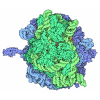
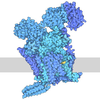
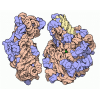
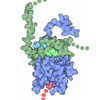

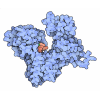

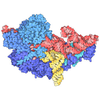


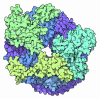







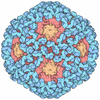










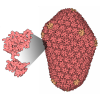
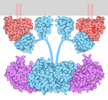

 Z (Sec.)
Z (Sec.) Y (Row.)
Y (Row.) X (Col.)
X (Col.)





































